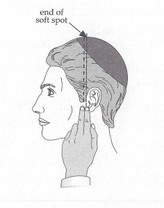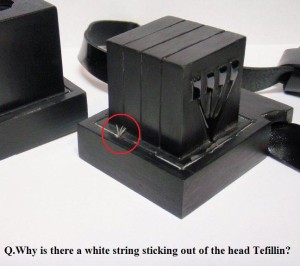 Actually, it is not any ordinary string; it is hair from a kosher animal. It is a Halachah transmitted to Moshe at Sinai, that all of the Parshios (Tefillin text) need to be wrapped with hair of a kosher animal. It is customary to use the hair from the tail of a calf, and the reason it sticks out of the head Tefillin is so we will constantly see it and be reminded of the Cheit Haeigel (the sin of the golden calf). This will keep us humble and prevent us from coming to sin. The general custom is not to be too particular about how many hairs stick out of the head Tefillin, though it is preferred to have at least two. If the hairs were never pulled out or they were but slipped back inside, the Tefillin are still kosher bedieved (when you have no other Tefillin and have no local Sofer to bring it and get it fixed). Therefore, it would be important to take care of it as soon as possible.
0 Comments
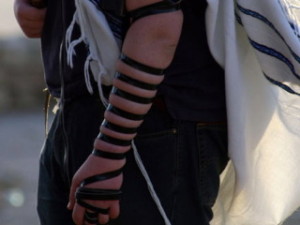 No, there may be no separation between the body and the Tefillin batim/boxes or the Retzuah/Teffilin straps that encircles the head or the upper arm which hods the Hand Tefillin box in place. Preferably there should not be any separation between the body and the rest of the Tefillin strap as well. This includes, shirt sleeves, watches or a Kipa, if one wears a toupee it must be removed before putting on Tefillin. If medically necessary it is permitted to wear a medicinal patch or bandage under the Rezuah Shel Yad/Hand Tefillin Strap. If medically necessary it is permitted to wear a medicinal patch or bandage under the Rezuah Shel Yad/Hand Tefillin Strap. Someone who, G-d forbid, broke their arm continues to place Tefillin on the broken arm (the Halachic authorities only have a doubt if the arm is permanently paralyzed). If the cast is only on the arm and not on the bicep, then one makes a Bracha/Blessing and puts the Tefillin on the bicep and wraps the strap over the cast. If the cast covers the bicep the Tefillin is placed on the bicep (and wrapped around the arm) but without a Brachah. Even in such a case a Brachah must be made on the head Tefillin. There should be no writing on the underside of the Straps. Some Rabbis consider long bangs to be a separation between the Tefillin and the head. A person should also take in to consideration that it is hard to keep the Tefillin in the correct place if it is resting on long thick locks of hair. The underside of the Retzuos must rest against the arm and the head. No part of the Retzuah/Tefillin Strap may be flipped over that the underside is visible. 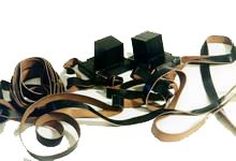 To prevent your Tefillin from getting lost, mark your name, address, and telephone number on or inside your Tefillin bag and on the individual Tefillin cases. (Do not put labels over the air vents of the Tefillin cases.) Take note of identifying marks on your batim, leather housing and Retzuos / straps. ( we give labels out free of charge if you need stop by the office.) In order not to lose your Tallis and Tefillin when traveling, be sure to keep them in your suitcase or carry-on bag. Don't carry them separately. When taking a bus keep your Tallis and Tefillin bag on your lap or inside a bag or briefcase with your other things. If one is traveling alone, he may take his Tefillin into the washroom, as long as they are inside a second bag. Do not leave your Tefillin sitting out in Shul or in school. If there is no locked cabinet or room available, put them away in a closed cabinet or out of sight. Similarly, if you absolutely must leave your Tefillin in the car, they should be kept out of sight. An attractive Tefillin bag may entice someone to break in and steal it. Students and campers: Do not put your Tefillin bag on top of your laundry bag when returning home! You will not be happy if they accidentally go into the washing machine. Protecting the Bayis Shel Rosh The Tallis should not be covering over the Shel Rosh. In additoin to the Halacha that it needs to be uncovered in reference to the verse וראו כל עמי הארץ כי שם ה נקרא אליך ויראו ממך (and all the nations of the earth will see that the name of G-D is called upon you and the nations of the world will fear you") Chazal say this refers to the Tefillin Shel Rosh "Shem Hashem Nikrah" start with the letters שין They will see the ש and fear you Chazal say this is the ש of the Shel Rosh. In addition it will gradually cause the paint to wear off the Bayis's (leather housing, singular) corners and the edges and cause them to lose their sharpness. A tallis with a silver atarah (adornment) is heavier than a regular tallis and will therefore cause the paint on the corners to wear off more quickly. If you regularly wear your tallis over your shel rosh, you must keep a close eye on its corners and edges. A black, plastic shel-yad cover can be cut out in order for the shins to be visible and placed on the shel rosh to protect it. Those who wear a hat during Shachris (morning prayers) should try to prevent it from resting on the edges of the shel rosh. When putting on your tefillin in the morning, it is best to hold the plastic shel rosh case upside down to minimize the chance of the bayis falling and then carefully open the bottom of the case and remove the bayis in a way that it will not rub against the case. Replace it in the same manner. The Shel Rosh case should not be too tight so that it will not wear the paint off the sides and corners of the bayis. It should also not be loose enough for the bayis to move around inside. If a piece of felt lining in the case falls out, replace it right away. If the Bayis Shel Rosh has no glue between the compartments of the ketzitzah, upper cube, it should be kept in a snug case whenever it is not being worn to help prevent the four compartments from opening. This is likely to gradually cause the paint to wear off the edges and the shins, and the bayis will require more frequent touching up. Protecting the Bayis Shel Yad It is a Halacha in Shulchan Aruch to have a covering over the Shel Yad. It is Known as a Yadlich, because the Tefillin Shel Yad is covered by the shirt sleeve it is constantly being rubbed which will cause the corners to round and paint to come off, Sometimes the Yadlich doesn't fit properly and it is constantly falling off, the solution is not to stop using it, Without an inner cover, the bayis will bounce around inside the plastic case. A piece of paper, tissue, or felt can be placed or glued into the inner cover to hold it snugly on the bayis. ( If you don’t have felt stickers, stop by the office and I will put one in at no charge). The inner, black shel yad cover should be slightly taller than the bayis so that it will not rub the corners. General Protection of Batim When you put on your Tefillin, position yourself over your Tallis and Tefillin bag, which should be resting on a table. If your Bayis slips from your hand, the table and bag will break the fall, preventing or reducing the damage. -Try not to handle the Batim by the corners and edges. -Do not daven too close to a wall or bookcase. You may accidentally dent a corner of one of the Batim. -Try not to regularly daven in a place where you will get sweaty, since sweat can cause the Batim to warp. If you perspire heavily, then:
Tefillin Paint Keep Tefillin paint handy, preferably in the plastic bag protecting your Tefillin bag. If the bottle is made of glass, keep it in a Ziploc bag in case it shatters. (I learned the hard way.) A Tefillin marker is also highly recommended. Unlike regular marker ink, it has rabbinical endorsement. The ink is jet black and will dry quickly. Furthermore, it is not glossy and it will blend well with the matte paint on batim. Test a Tefillin marker before purchase to make sure that it is not dried out. A marker has the advantages that it will not break or spill, but it will dry out and get used up more quickly than bottled Tefillin paint. Protecting the Retzuos (straps) It is important to handle your Retzuos gently so that the paint will not be rubbed off. Avoid rubbing the Retzuos against the zipper of your Tefillin bag, when you remove your Tefillin from the bag or put them back in. When you open and close the Shel Yad Tefillin case, take care not to let it scratch against the knot. Also, the case should not press against the knot when it is closed, since it will cause the paint to wear off. You may need to slightly enlarge the opening for the knot by trimming the case at the points where it rubs or presses against the knot. Do not wrap your Retzuos tightly around your arm or the cases. This will cause the Retzuos to gradually stretch and the paint to crack. When the Retzuos are pulled through the Maavarta, (passageway in the batim) the edges of the top surface may be frayed or scuffed. This is not a Halachic problem as long as the retzuos remain black. In order to prevent the retzuos from being scuffed or gradually worn from within the maavarta, ask the sofer to smooth out any bumps inside. [391] If the Retzuos of the Shel Rosh (head Tefillin) That hang over your body do not stay on the black side when being worn, pull them through your belt to prevent them flipping onto the unpainted side. Never leave Tefillin in direct sunlight, extreme heat or cold, rain, or a very humid room. Tefillin should not be left in a car or trunk, near a window, or on a radiator. When traveling, do not put your Tefillin in a suitcase that will be put in the airplane's hold. Rather, take it on board in your carry-on luggage. I remember a few instances from my Yeshivah days, One of my Chaveirim would put his Tefillin on the window sill every morning after Shachris. When the time came to have them checked it was discovered that many of the letters were full of cracks. Unfortunately he didn't realize the sun shone on his Tefillin all afternoon. Another Student kept it on the window sill overnight and I remember how the window was left open by accident and it rained during the night and his Retzuos got all wet and started bubbling... I don't remember hearing about the status of the Parshios... If you go directly to work or school after davening, store your Tefillin either in Shul or in the office or school. If you have no choice but to leave your Tefillin in the car, they must be kept out of sunlight and stored in a hot-cold protective container. A special Tefillin container with a thermal lining is on the market and available for purchase on our website via this link If you are careful to put on Tefillin before going to Shul be sure to take proper precautions to prevent the Tefillin from getting wet on a rainy morning. Position in Bag Halachah requires that the Shel Yad be removed from the bag before the Shel Rosh. In order to facilitate this, the entire Retzuah of the Shel Yad should be wrapped on one side of the case, making it wider than the Shel Rosh and automatically closer to the opening. Halachah requires that the Tallis be removed from the bag before the Tefillin. In order to guarantee this, the Tallis should always be placed on top of the Tefillin bag inside the larger Tallis bag. As well keeping your Tefillin in a plastic bag as opposed to cloth will save your Tefillin from rain, or your friends coffee that accidentally spills on the table where you are davening. I just had someone in my office, he explained to me that he has always had a hard time making sure the knot on his arm Tefillin touches the actual Tefillin box as is required.
I looked at it and realized right away that his Tefillin knot was on upside down. That is a problem. *Lesson* If you are having any problems with your Tefillin be sure to have a Certified Sofer/Scribe take a look at it. 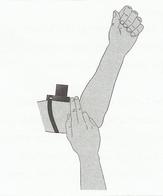 Shel Yad/Hand Tefillin The Tefillin Shel Yad is worn on the weaker arm, because there is a Limud from the posuk/verse in Parshas/(Torah portion) “Vehoyo Ki Yiviacho” which writes regarding the Shel yad that it is placed “al Yodchah”(on the arm) it is written with a seemingly extra letter hey after the chof , Chazal learn out from this “Yad Keho” which means “the weaker arm”. So for a right-handed person it is placed on the left arm and a left handed person wears the hand Tefillin on his right arm. Someone who is ambidextrous should wear it on his left arm. Someone who writes with one hand and all his other activities with the other should consult a Rav. The Titura of Bayis ( the base of the Tefillin) must rest on the center of the width of the biceps muscle and lean slightly toward the heart. The Shulchan Aruch and the Ramah hold that no part of it may rest and higher than the midpoint of the humerus bone -which is the bone that stretches from the shoulder to the elbow-. According to the Gra however it can go higher up, just no higher than the top edge of the biceps muscle. The lowest point that Titura may rest is on the lower edge of the biceps muscle, if it is any lower it is as if you are not wearing Tefillin. Now some hold that 1) this is determined when the arm is bent at an approximate 90 degree angle. 2) while others hold it is when the arm is outstretched and relaxed. You can determine its position by locating the base of the muscle with your finger and making sure that the front edge of the Titura is above it. As a general rule: If you can place your index and middle finger between the cleft of the arm and the front edge of the Titura when the arm is bent at an approximate ninety degree angle then it is most likely in the proper position according to the first opinion. And if you can place your pinky ring and middle fingers, then it is in the correct position according to the second opinion. As well the knot must be touching the Box the entire time you are wearing the Tefillin. Proper placement of Tefillin Shel Rosh The entire Bayis Shel Rosh(Head Tefillin) must rest above the original hairline which is determined by the hair roots of each individual person. If any part rests below, it is considered that the Tefillin are not being worn. Someone who’s hairline has receded should continue to place the entire Bayis shel rosh above his original hairline. If one looks closely at his forehead he can locate his original hairline as the part of the forehead where the hair once grew looks different then the rest of the forehead. In addition the Tefillin must be centered so that the middle of the bayis will rest directly above the bridge of the nose. The back edge of the bayis can reach until the top of the head, which is equivalent to the end of the soft spot on the baby’s head, this area can be identified by running the tip of ones finger straight upward from the front of the ear. Placement of the knot of the Shel RoshThe majority of the knot must rest on the center of the base of the skull, and the remainder of the knot may rest just below it in the indentation on the nape. Many people mistakenly think that the proper placement of the knot is completely in this indentation. If the knot is below the bone at the base of the skull then as long as the entire knot is above the hairline it is still acceptable. Tefillin straps tend to gradually stretch causing the bayis and knot of the Shel Rosh not to rest in their proper place, the straps of the Shel Rosh should be adjusted as necessary. 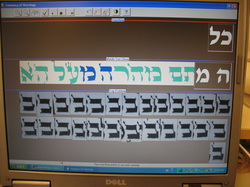 Computer checkingIn addition to a Sofers examination, we strongly recommended you to have a computer checking done as well. Although examiners do the best they can, humans can make mistakes which the computer can catch. However, it is not a substitute for the manual examination, for although the computer can successfully catch missing and substituted letters, it can not determine letters with a problematic shape if they are Kosher or not, or do the actual repairs if necessary. This can only be accomplished through a meticulous manual examination by a qualified Sofer. The cost for a computer examination is minimal and a one time expense. If you have never had your Teffilin or Mezuzos computer checked, it is advisable to do so the next time you have them examined. 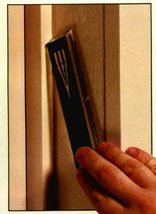 The Kitzur Shulchan Aruch states that Mezuzos and Tefillin should optimally be checked on a yearly basis. If that is not possible then Mezuzos must be checked at least every three and a half years. Tefillin, However, have no mandatory time frame for checking. Rather they should be checked based on how they are handled, how often they are used, and atmospheric condition. As such. it is a good idea to inspect your Tefillin boxes and straps from time to tome to ensure that they are Kosher. If you have any doubts or concerns, or if you have a reason to suspect something is amiss, they you should have your Mezuzos and Tefillin checked right away. By checking your Meuzuzos regularly you will prevent serious problems from occurring as well as a potential big expense of having to replace your Mezuzos. If the letters start to grey or if the letters and crowns begin to form a small crack and break this will cause the Mezuzah to become not Kosher, if caught in time it can be fixed, however if it goes years without attention chances are it will be too late the breaks will be to big to be able to fixed and it will have to be replaced. As well unfortunately there are Mezuzos and Tefillin that were Not Kosher from the get go, and when a Sofer Checks Mezuzos or Tefillin there are many potential problems he is looking out for, such as: Letters, Words or/and Tagim that are Missing, Extra, Substituted, Touching, Broken. Improperly Spaced, Deformed. Faded, Cracked and weather damaged. As you can imagine that is a a lot to focus on while checking a Mezuzah or Tefillin. Very often when a Mezuzah has a lot of one particular problem such as problematic spacing the Sofer will be giving most of his attention to fixing the problematic spacing and not be giving 100% to other areas such as missing or added letters... Therefore the more often a Meuzah or Tefillin is checked the greater the chance all problems if any will be discovered. |
Categories
All
AuthorRabbi Kass was ordained by Rabbi Yisrael Meir Lau, former Ashkenazik Chief Rabbi of Israel. He is certified as a Sofer for both Kesivah and Hagoah by one of the leading experts in Safrus, Rabbi Avrohom Tzvi Vosner, Rav of the Vad Mishmeres Sta”m. Archives
March 2018
|
What our clients say about us: |
To enhance our service quality, we operate on an appointment-only basis.
Please contact us to make an appointment. $12.99 Flat rate shipping! Mezuzahs, Tefillin & Accessories! |
|

